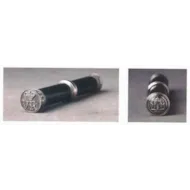An English Victorian ceremonial tipstaff of wood and silver
An English Victorian ceremonial tipstaff of wood and silver
19th CENTURY
Size: 11.5cm long, 1.5cm dia
19th CENTURY
Size: 11.5cm long, 1.5cm dia
A tipstaff has its origins in the 16th century when the word was used
to denote a metal tipped staff that was a sign of office or authority. Tipstaffs often have ends that unscrew to reveal a small compartment
where a writ could be concealed. These writs could either be from a law
court or from the Office of the Crown summoning a peer to Parliament. The more ordinary use of the tipstaff is the one carried by a sheriff's
officer or a constable in the course of his duties, and this developed
in the 19th century into the colourfully painted truncheon.
to denote a metal tipped staff that was a sign of office or authority. Tipstaffs often have ends that unscrew to reveal a small compartment
where a writ could be concealed. These writs could either be from a law
court or from the Office of the Crown summoning a peer to Parliament. The more ordinary use of the tipstaff is the one carried by a sheriff's
officer or a constable in the course of his duties, and this developed
in the 19th century into the colourfully painted truncheon.
An English Victorian ceremonial tipstaff of wood and silver

SOLD
YOU MAY ALSO LIKE

